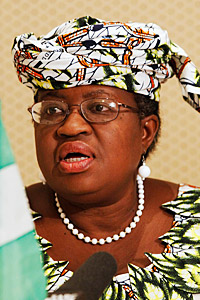
When you think of teenage girls, you might imagine common stereotypes, from the "mean girl" to the sullen high school student locked in her bedroom. The reality is that teenage girls are not only some of the world's most marginalised people; they also have virtually unmatched potential to help build a better future for all.
As it stands, adolescent girls are routinely denied control over their destinies. More than 32 million of the poorest are currently out of school. Every day, 39,000 girls under the age of 18 become someone's wife. For huge numbers of girls worldwide, reproductive rights seem like an impossible dream.
This situation is morally reprehensible, socially self-defeating, and economically foolish. By addressing it, we could not only protect millions of children; we could also tackle some of the greatest challenges facing the world today.
Consider the challenge posed by rapid population growth. Though population size seems to be levelling off in most parts of the world, it continues to rise fast in some regions, particularly those where girls face the highest barriers to success. In Africa, the population is expected to double by 2050 and quadruple by 2100.
If teenage girls were given the knowledge, skills and tools to avoid unwanted pregnancy and take control of their own futures, fertility rates would drop substantially. These newly empowered and educated girls could then become agents for broader positive change within their communities.
Protecting the world's young girls is a tall order. But countries worldwide have pledged, through the ambitious Sustainable Development Goals (SDGs) programme, to fulfill it by 2030, including by ending child marriage and ensuring that all girls are in school. But if countries are to succeed in protecting and empowering girls, they must also embrace the promise of a key initiative: to expand access to the vaccine for human papillomavirus, which causes the vast majority of cervical cancer cases.
A relatively new development, the vaccine for human papilloma virus (HPV), is most effective on girls aged nine to 13 who have not yet been exposed to the virus, meaning they have never been sexually active. This age requirement differentiates the HPV vaccine from most other childhood vaccines, which are mainly given to infants.
At first glance, this might seem like a disadvantage, because the HPV vaccine cannot simply be incorporated into other vaccine initiatives. In fact, the age requirement provides an important opportunity to reach adolescent girls with other vital health services, such as reproductive education, menstrual hygiene, deworming, nutrition checks, vitamin shots and general check-ups.
Encouragingly, developing country governments have increasingly been demanding the treatment. This makes sense: Of the 266,000 women who die from cervical cancer every year -- an average of one every two minutes -- 85% are in developing countries. If left unchecked, that figure is expected to rise to 416,000 by 2035, overtaking maternal deaths. For many of these countries, the HPV vaccine is not just an effective solution, one that prevents 1,500 deaths per 100,000 vaccinated; it is often the only solution, because the poorest countries lack the capacity to offer screening or treatment for cervical cancer. This is one reason why cancer experts, government officials, private-sector leaders, and civil society representatives met a few weeks ago in Addis Ababa for the tenth Stop Cervical, Breast and Prostate Cancer in Africa conference.
There is more good news: The foundations of an HPV-vaccine initiative have already been laid. In 2013, well before the SDGs were agreed, Gavi, the Vaccine Alliance, for which I serve as chair, took steps to make the HPV vaccine available and affordable in poor countries. Since then, we have seen 23 countries introduce the vaccine through demonstration pilot projects.
But there are significant challenges ahead. While the focus on holding vaccination sessions in schools has proved successful, it is inadequate for reaching girls in countries with low school attendance rates, especially in urban areas. Unless we find a way to reach the most vulnerable groups, no amount of political will or financing will be enough to achieve the SDGs to protect women and girls.
Given that only two Gavi-supported countries, both of which have relatively high enrolment rates, have so far introduced the vaccine nationally, it is not clear how difficult it will be to overcome this challenge. We do have some ideas for reaching girls who are not in school, such as community health centres. As it stands, women are most likely to go to a community health centre when they are pregnant, or to have their infants vaccinated. But by engaging with community leaders and parents to raise awareness of prevention and address other local health concerns, we are finding it is possible to generate demand.
Ensuring that all girls have access to the HPV vaccine would improve countless lives, not only by reducing rates of cervical cancer, but also by enabling the provision of other critical services. It is an opportunity that should be on the minds of cancer experts, officials, the private sector and civil society. And it is an imperative for all of the 193 governments that have signed up to the SDGs. We must not let our girls down. Project Syndicate
Ngozi Okonjo-Iweala, a former Nigerian minister of finance and managing director of the World Bank, is head of Gavi, the Vaccine Alliance.
